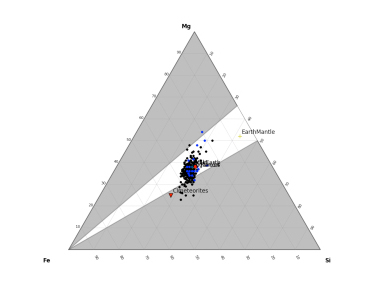2014 Annual Science Report
 Arizona State University
Reporting | SEP 2013 – DEC 2014
Arizona State University
Reporting | SEP 2013 – DEC 2014
Astrophysical Controls - Task 7 - Update Catalog of Elemental Ratios in Nearby Stars
Project Summary
Abundances of both common and trace elements can have substantial effects on the habitability of stellar systems. Elemental ratios can change the stellar evolution and mineralogy, geophysics, and surface processed of planets. We study the abundances of large samples of nearby stars and individual systems and the extent of their variation. We examine ratios of elements that have substantial effects of the mineralogy and interiors of planets. The relative abundances of common elements vary substantially among nearby stars. Extremely non-solar abundance ratios at the level that can produce substantial changes in planetary and stellar properties are present in interesting numbers.
Project Progress
The Hypatia Catalog of stellar abundance determinations was published and made available to the community. In addition to the comprehensive nature of the catalog and the important finding that abundance determinations between groups are often not consistent, a new ensemble of stars with distinct abundance patterns very close to the Galactic midplane was discovered. This catalog serves as a foundation for work characterizing exoplanetary systems.
As part of the NAI-supported “Stellar Stoichiometry” Workshop Without Walls hosted at ASU in April 2013 we began a collaboration to determine why measurements of abundances for a given star by different research groups often differ by more than the quoted observational errors. We now have five separate research groups systematically analyzing a set of data with their own techniques and various control situations such as fixed stellar parameters and line lists. The abundance determinations have been completed and are currently being analyzed and prepared for publication. Results indicate that discrepancies arise from multiple sources. An expanded collaboration will begin work on preparing a recommended set of best practices.
Pagano and Young have derived abundances of ~500 stars (from spectra obtained by Paul Butler, Carnegie Institute for Science), of which 30 are known planet hosts. Working with mineralogy experts Sang-Heon (Dan) Shim and Tom Sharp (ASU) they developed a method for using standard mineralogical ternary diagrams to evaluate stellar compositions for the potential to produce exotic planetary compositions (see figure 1 for an example).
Based on the distribution of abundance ratios found by this work, Patrick Young and Amanda Truitt (ASU) have created a grid of stellar models and predicted habitable zones for 0.5 – 1.2 solar masses, 0.1 to 1.5 times solar metallicity, and O/Fe ratios of 0.5 to 2 times solar with the TYCHO stellar evolution code (see Task 2).
A pilot project for characterizing individual stars and planetary systems with detailed compositional information was carried out for tau Ceti by Michael Pagano, Patrick Young, Amanda Truitt, and Sang-Heon (Dan) Shim (ASU) (see also task 2). This work derived new abundances from high resolution spectra, created custom composition stellar evolution models for Tau Ceti and its habitable zone, and found that Mg/Si ~ 2 and Eu/Fe is substantially greater than solar. Due to the high Mg/Si ratio, planets in this system are likely to be in the transition region from having an Earth-like lower mantle dominated by stishovite and spinel to perovskite and ferropericlase. The mantle viscosity may decrease by two orders of magnitude in these conditions. This highlights the need for geophysical modeling of planets with exotic compositions. Low viscosity and high radionuclide abundance may mean planets remain geologically active at the relatively old age of tau Ceti (~8Gy), but energy transport to the surface from the planetary interior may be higher.

Publications
-
Hinkel, N. R., Timmes, F. X., Young, P. A., Pagano, M. D., & Turnbull, M. C. (2014). STELLAR ABUNDANCES IN THE SOLAR NEIGHBORHOOD: THE HYPATIA CATALOG. The Astronomical Journal, 148(3), 54. doi:10.1088/0004-6256/148/3/54
-
Pagano, M., Truitt, A., Young, P. A., & Shim, S-H. (2015). THE CHEMICAL COMPOSITION OF τ CETI AND POSSIBLE EFFECTS ON TERRESTRIAL PLANETS. The Astrophysical Journal, 803(2), 90. doi:10.1088/0004-637x/803/2/90
-
Truitt, A., Young, P. A., Spacek, A., Probst, L., & Dietrich, J. (2015). A CATALOG OF STELLAR EVOLUTION PROFILES AND THE EFFECTS OF VARIABLE COMPOSITION ON HABITABLE SYSTEMS. The Astrophysical Journal, 804(2), 145. doi:10.1088/0004-637x/804/2/145
-
Young, P. A., Desch, S. J., Anbar, A. D., Barnes, R., Hinkel, N. R., Kopparapu, R., … Truitt, A. (2014). Astrobiological Stoichiometry. Astrobiology, 14(7), 603–626. doi:10.1089/ast.2014.1143
-
PROJECT INVESTIGATORS:
-
PROJECT MEMBERS:
Patrick Young
Project Investigator
Francis Timmes
Co-Investigator
Margaret Turnbull
Co-Investigator
Natalie Hinkel
Collaborator
Michael Pagano
Collaborator
Sang-Heon Shim
Collaborator
-
RELATED OBJECTIVES:
Objective 1.1
Formation and evolution of habitable planets.
Objective 7.2
Biosignatures to be sought in nearby planetary systems